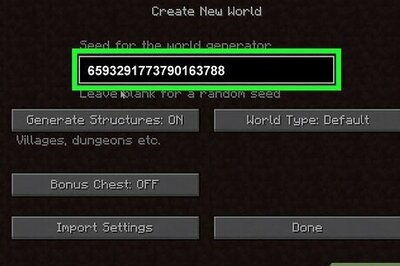
views
X
Research source
This is one of the most useful calculations in baseball, as it shows the pitcher's overall effectiveness.
Understanding Earned Run Average

Know a bit more about earned run average. Earned run average is the number of times a man from the opposing scores a run due to the fault of the pitcher. This could be because of three things: The batter made a hit. Although it does mean the pitcher threw a strike, it counts against his earned run average. The pitcher walked the batter. This could be the result of the pitcher throwing four balls or hitting the batter with the pitch.

Understand the rules. To calculate an accurate ERA, you must have accurate numbers. You need to know the earned runs, but to do this you have to look at when the pitcher was pulled from a game. For example, if a pitcher played three innings and in the fourth inning allowed a man on every base and then was pulled, all three of those men would count against his ERA. They do not transfer to the next pitcher simply because he was the one pitching when they made it across home plate.

Make sure you don't count unearned runs in your calculations. Whereas earned runs are caused by hits and are the fault of the pitcher, unearned runs are usually caused by errors or passed balls and are not strictly the fault of the pitcher. Unearned runs do not count towards a pitcher's ERA. For example, there are runners on 2nd and 3rd base, with 2 outs. The pitcher throws a pitch to the batter, which ends up being a routine ground ball to the first baseman, but the first baseman bobbles it and can't make a play to get an out. One runner scores, and two are still left on base. The run is unearned, and if the two remaining runners on base happen to score, their runs also count as unearned.

Know the required fields. To calculate ERA, you need three parts: the earned runs, the innings pitched, and the total number of innings. Earned runs, as explained above, are the number of times a pitcher lets a batter get on base. This is the total number for the whole game. The innings pitched is just like it sounds, the total number of innings this pitcher pitched. This number will always end in thirds. That is because for every inning three strikes can be made by the fielding team. That leaves three possible outcomes: a whole inning (three outs), an inning with two outs (ends in .66), or an inning with one out (ends in .33). The total number of innings refers to the number of innings in a complete game (9).
Calculating Earned Run Average

Gather your information. You will have three numbers to use in your calculation. For example, say that Joe Smith plays for 6 innings in a 9-inning game and allows 3 men to score.

Make the first calculation. For this, divide the number of earned runs by the number of innings played. Following our example, it would be 3/6, giving us the number .5.

Multiply this number with the total number of innings. That means we would take our number of .5 and multiply it with 9, giving us 4.5.

Test your number. Depending on your preference, you can calculate ERA two ways. The first (shown above) is ERA= total innings(earned runs / innings pitched). You can also formulate it as ERA = earned runs x total number of innings / innings pitched. Test your answer using the alternate method. Peter Gammons Peter Gammons, Baseball Journalist The earned run average statistic revolutionized how players were evaluated, as it provided the first strong metric of a pitcher's true performance. No longer could fielders' errors mask a hurler's deficiencies, as only runs that scored without aid of errors were charged against the man on the mound. From the moment it was popularized in 1912, ERA became baseball's most hallowed measure.


















Comments
0 comment